Neuroscience of Happiness
Stop chasing Dopamine - The Anticipation Chemical That Shapes Our Happiness
NeuroMastery Cohort 5 is stating on 1 Feb 2025. Just one week left to enroll. If you want to know more and be a part of this community of Neuroscience enthusiasts, Book a discovery call now.
A few days ago, I saw an interesting question pop up on my Instagram reel:
"Where can we get more dopamine?"
Dopamine is widely known as the “pleasure chemical.”
It’s often associated with happiness, and naturally, people want more of it.
But here’s the paradox:
The more dopamine you get from an activity, the less happiness you feel from doing it over time.What is Dopamine Really?
Dopamine is not exactly a pleasure chemical. It’s actually the anticipation of pleasure.
That’s right!
Dopamine spikes when you anticipate something good happening, but the moment you get the reward, the spike fades. The more often you get a reward, the smaller the dopamine spike becomes.
Dopamine is the anticipation chemical.
And because of this, we get caught in what’s called the "variable rewards" phenomenon.
This means that not succeeding every time (inconsistent rewards) can actually make success feel more rewarding when it does happen.

How to get more dopamine?
The key is increasing the effort needed to achieve that dopamine spike.
Why More Effort Means More Happiness
It sounds counterintuitive, right? Wouldn’t we be happier if things required less effort?
But evolution has a way of shaping our desires and expectations.
Historically, activities that gave you a big dopamine spike—like finding food or a suitable partner—required great effort.
However, times have changed. Now, many of those same rewards are available with much less effort. But the brain has not evolved quickly enough to handle this. So, while you can now get rewards with less effort, the dopamine response stays the same.
Earned Pleasure vs. Cheap Pleasure
This leads us to the concept of two types of pleasure:
Level One: Earned Pleasure (True Happiness)
In the past, to get a reward (like food or a partner), it took significant effort. This is earned pleasure, and when you achieve it, it results in a big dopamine spike.
Level Two: Cheap Pleasure (Instant Gratification)
Today, we can get the same rewards without much effort. This is cheap pleasure. Examples include:
Addictive substances (like cigarettes or alcohol)
High-calorie foods
Pornography
These activities give you a quick dopamine spike, but because they’re not earned through effort, they don’t provide long-lasting happiness.
How to Increase Dopamine in a Healthy Way
There are two ways to get more dopamine from earned pleasure:
Step 1: Make Cheap Pleasure More Difficult
You can either:
Increase the waiting time for rewards.
Increase the effort needed to obtain cheap pleasure.
For example, you can:
Deny yourself Netflix unless you finish a specific task.
Make eating a high-calorie dessert conditional on doing 15-30 push-ups.
By introducing obstacles, you make the pleasure earned and more rewarding.
Step 2: Make Earned Pleasure Easier
Make sustained effort a habit. Your brain wants to conserve energy, so it resists putting in effort unless it’s necessary. But if you build discipline and make certain tasks habitual, it becomes easier to achieve earned pleasure.
With discipline, your prefrontal cortex can override the brain’s resistance and help you stick to your goals.
The Takeaway
Dopamine isn’t just about pleasure—it’s about the anticipation of rewards. By increasing the effort required for rewards, you can experience more meaningful dopamine spikes.
So, the next time you're thinking about what you can do to get more dopamine, consider increasing effort for the things that matter.
PS: Understanding how dopamine works can completely change the way you approach habits and motivation. If you're ready, dive deeper into the NeuroMastery Program, learn how to master your brain’s rewards system, and start taking control of your happiness today. Join now to take action and transform your life—just like many others in our community!





